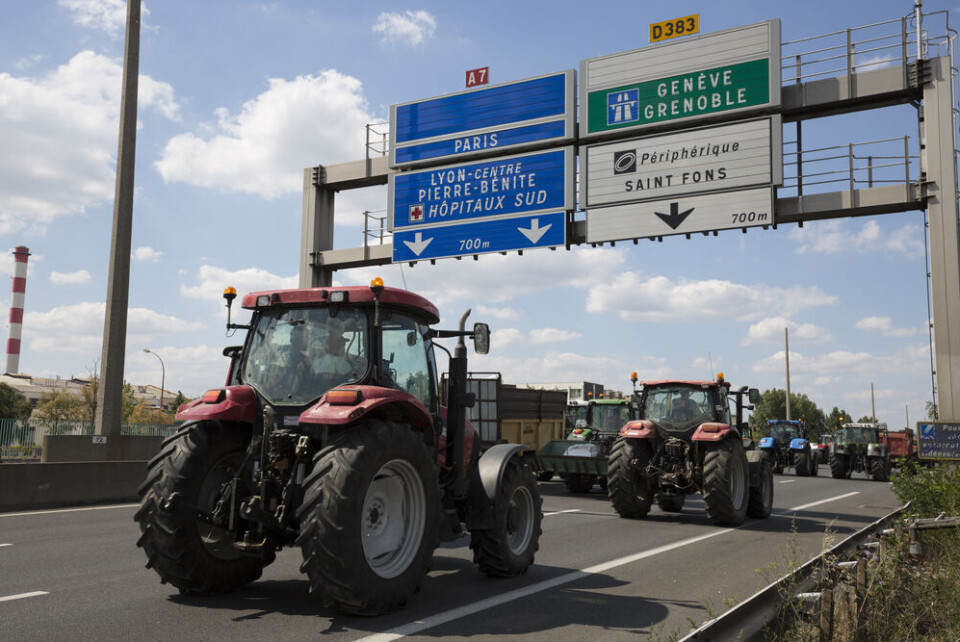-
White storks make strong return in France via nest ‘platforms’ and clipped wings
The Ligue pour la Protection des Oiseaux shares the conservation challenges in saving these birds from extinction
-
Hosting scheme in south-west France lets newcomers sample lifestyle
Households in nine Dordogne communes volunteer under Mes Nouveaux Voisins scheme
-
French boulangeries demand right for staff to work on May 1 so they can open
Artisan bakery owners can work but employees cannot, while certain industrial bakeries are allowed to remain open with workers
Travel disrupted around France as farmers blockade Paris and Lyon
The government response stiffens as 15,000 police are deployed to protect the capital

The French farmer protest is intensifying around Lyon and Paris, as the Interior Minister orders 15,000 police to prevent their entry into the capital.
Farmers have been protesting since January 20 using parked tractors and bales of straw to create roadblocks on motorways around the country, while in other places they are deliberately slowing traffic with rolling barricades.
Read more: SEE: support for French farmer protests higher than for gilets jaunes
They began to converge around Paris on Friday (January 26), with the intention of “blockading the capital”, according to farmers’ union FNSEA.
However, Interior Minister Gérald Darmanin announced the deployment of 15,000 police and gendarmerie along with armoured vehicles and helicopters to prevent disruption. Mr Darmanin called the farmers’ entry into the capital a “red line”.
The Interior Minister had previously declared that he “would like to support them politically” on January 28.
Travellers should anticipate severe delays on motorways around the country, even if farmers’ protests are not announced for the area, as farmers from many regions are expected to drive their tractors to the capital.
No delays have been announced at the ports, however farmers have declared their intention to block traffic around Toulouse-Blagnac Airport.
Where are the farmers’ barricades on January 29?
|
Region |
Roads |
Where |
Type |
|
Auvergne-Rhône-Alpes |
Around Lyon |
Rhône |
Roadblocks |
|
A450 |
From Monts du Lyonnais, Loire/Rhône |
Rolling barricades | |
|
A450 |
Oullins-Pierre-Bénite, Rhône |
Roadblock | |
|
A7 |
Around Lyon |
Rolling barricades | |
|
A47 |
Around Lyon |
Rolling barricades | |
|
A43 |
Saint-Quentin-Fallavier, Rhône |
Roadblock | |
|
A6 |
Villefranche-sur-Saône-Limas, Rhône |
Roadblock | |
|
A480 |
Isère |
Roadblock | |
|
A7 |
Isère |
Roadblock | |
|
A48 |
Isère |
Roadblock | |
|
A43 |
Isère |
Roadblock | |
|
Brittany |
N165 |
Quimper, Finistère |
Roadblock |
|
N164 |
Carhaix, Finistère |
Roadblock | |
|
N165 |
La Roche-Bernard, Morbihan |
Roadblock | |
|
Bourgogne-Franche-Comté |
A77 |
Cosne-Cours-sur-Loire, Nièvre |
Roadblock |
|
Grand-Est |
N58 |
Between Sedan (Marne) and Bouillon (Belgium |
Roadblock |
|
Hauts-de-France |
Around Amiens |
Somme |
Roadblocks, rolling barricades |
|
A16 |
Between exits 11 and 16, Oise |
Roadblocks | |
|
A1 |
Between exits 11 and 6 | ||
|
A16 |
Oise |
Rolling barricades | |
|
A1 |
Oise |
Rolling barricades | |
|
A16 |
Between Etaples, Wailly-Beaucamp and Isques, Pas de Calais |
Roadblocks | |
|
Ile-de-France |
A1 |
Chennevières services, Val-d'Oise |
Roadblock |
|
A4 |
Jossigny, Seine-et-Marne |
Roadblock | |
|
A5 |
Ourdy, Seine-et-Marne, |
Roadblock | |
|
A6 |
Villabé, Essonne |
Roadblock | |
|
A10 |
Longivilliers, Yvelines |
Roadblock | |
|
A12 |
Access to Paris |
Roadblock | |
|
A13 |
Buchelay, Yvelines |
Roadblock | |
|
A15 |
Gennevilliers, Hauts-de-Seine |
Roadblock | |
|
A16 |
Isle-Adam, Val-d'Oise |
Roadblock | |
|
Normandy |
A13 |
Between Gaillon and Vernon, Eure |
Roadblock |
|
Nouvelle-Aquitaine |
From Dordogne |
To Rugnis, Val-de-Marne |
Rolling barricades |
|
Occitanie |
A9 |
Nimes , Gard |
Roadblock |
|
Toulouse-Blagnac Airport |
Haute-Garonne |
Roadblock | |
|
Provence-Alpes-Côte d'Azur |
A50 |
Bouches-du-Rhône |
Rolling barricades |
|
A7 |
Bouches-du-Rhône |
Rolling barricades | |
|
A55 |
Bouches-du-Rhône |
Rolling barricades | |
|
Marseille town centre |
Bouches-du-Rhône |
Protest, rolling barricades | |
|
A8, Aix-en-Provence |
Bouches-du-Rhône |
Roadblock | |
|
A51 |
At A8 junction, Bouches-du-Rhône |
Roadblock |
How is the government reacting?
Prime Minister Gabriel Attal announced a series of measures aimed to satisfy many of the farmers’ demands on Friday (January 26), including:
- Eliminating the planned increases to the agricultural diesel tax
- Increasing sanctions against companies that circumvent the EGAlim law, which is intended to ensure farmers are paid fairly
- Opposing the European Mercosur accord with South American companies for food imports
- €50 in aid for farmers whose livestock were affected by the Epizootic hemorrhagic disease
- Unspecified measures to simplify the rules and regulations that affect farmers.
Read also: Will €3.5billion pledge be enough to secure future of French farming?
Are the protests losing momentum?
The government’s concessions along with its stiffening response to the protest has begun to cause the number of blockades to decrease.
The 400 km long closure of the A7 and A9 in the south of France has dissipated, as have many other local protests.
Nonetheless, Interior Minister Gérald Darmanin told FranceInfothat this might be a “difficult week”.
The remaining farmers are converging on Paris amid mounting evidence of convergences with other disgruntled unions.
Taxi drivers, in particular, are on strike, slowing traffic in Bordeaux, Toulon, Lyon, Lille, Tours, Marseille and Nice with rolling barricades.
On motorways in the Paris area, taxi drivers can now be seen parked alongside the farmers’ tractors in their ‘blockade’ of the capital.
Read more
Why French village and town road signs are being turned upside down?
























